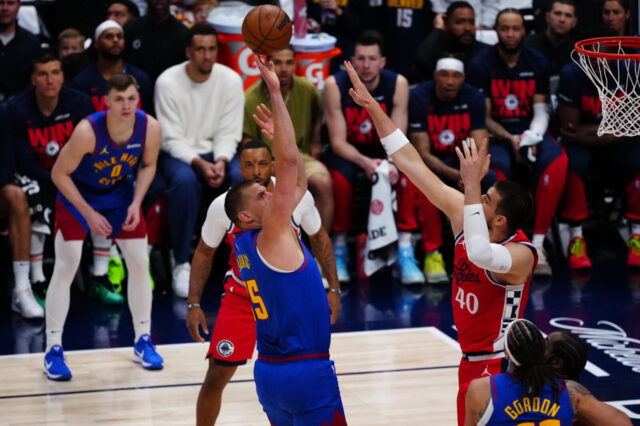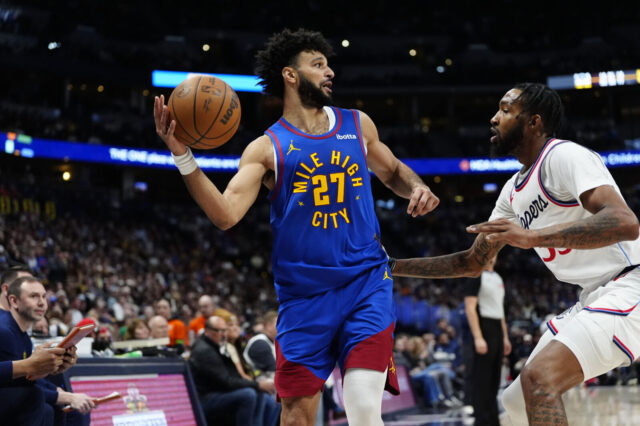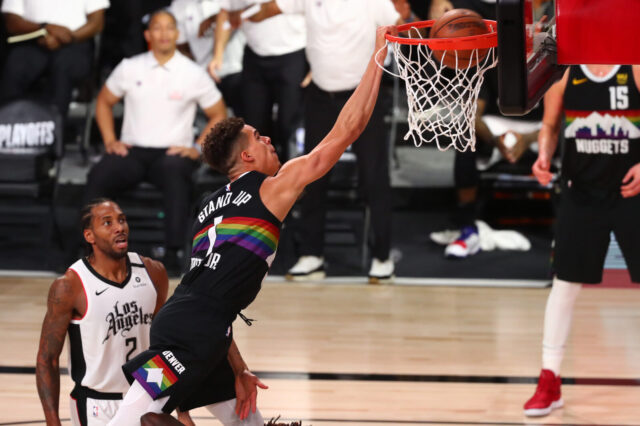It became apparent sometime during his sophomore season that Nikola Jokic was going to be the centerpiece of the Denver Nuggets for years to come. He was named the full-time starter on December 15th, 2016 but it probably wasn’t until a few weeks later that the Nuggets realized how every basketball decision they would make going forward would revolve around how it impacts Jokic. Every player added through the draft, free agency, and via trade has been brought in to compliment Jokic’s skill set.
Over that time, the Nuggets have been able to experiment with several different players at the power forward position, each of whom has brought a very different look. Paul Millsap has been the most successful front court pairing thanks to his defense, high basketball IQ, and his ability and willingness to take on a low-usage offensive role but Millsap works in large part because he is the most well-rounded front court partner and the best compliment defensively. There have been a few other players who have brought a more unbalanced skillsets with parts of their game that augment Jokic’s game even more than Millsap.
Three players in particular stand out: Kenneth Faried, Juancho Hernangomez, and Mason Plumlee. All three have weaknesses in their game that have limited their ability to play heavy minutes alongside Jokic but each has a skill that, at their best, elevates the Nuggets toward new heights. Jerami Grant, Denver’s latest free agent acquisition and potential long-term answer at the power forward position alongside Jokic, possesses some of the best traits of all three players. In many ways he is a combination of all three guys.
Let’s take a look at what skills Grant brings to the table that have been proven to be successful with the Denver Nuggets.
Kenneth Faried
First, rewind to the 2016-17 season, the breakout year for Nikola Jokic. Kenneth Faried started 17 games alongside Jokic and the two shared the court for nearly 500 minutes. In those minutes, the Nuggets put up a 125 offensive rating, (ORTG) or points scored per 100 possessions. For reference, that mark is higher than the best ORTG for Steph Curry and Kevin Durant, James Harden and Chris Paul, or LeBron James and Kyrie Irving during any of their seasons together.
Faried brought three things to the table that really made him a perfect offensive pair alongside Jokic: transition offense, dunker spot gravity, and offensive rebounding.
Jokic is an elite defensive rebounder and the Nuggets have been one of the top defensive rebounding teams since his arrival. He’s also one of the league’s best outlet passers, a skill that fit perfectly with Faried’s high motor and fast end-to-end speed. Nuggets fans will remember both of these highlight plays.
Like Faried, Grant seems to have his finger on the turbo button at all times, especially in transition. He’s quicker than most forwards and has longer strides than most guards and wings. His ability to finish well above the rim when he gets running downhill creates a sense of urgency for the defense to get back quickly.
Then there’s Faried’s gravity from the dunker spot. Jokic’s most under rated pass is the drop-off pass in tight spaces, usually off of the short roll. As one of the most explosive dunkers to ever play in the NBA, Faried was a perfect recipient of these dropoff passes, able to elevate to the rim quickly before the defense can recover.
Few players jump as quickly as Faried but Grant, with his 8’11” standing reach, is a close enough facsimile. Watch how quickly Grant can go from outside of the painted area to the rim without using a dribble.
Denver has no shortage of three-point shooters around the perimeter, each of whom create an enormous amount of gravity above the break and in the corners. Having a player who can stretch the defense along the baseline creates another area on the court for the defense to cover and is often times even more valuable than having a fourth shooter out on the perimeter.
This leads directly to Faried’s offensive rebounding. With Jokic dragging opposing centers out on the perimeter, Faried was able to feast on the offensive glass. And even in those possessions when Jokic did not drop it off to Faried in the dunker spot, Faried was still in prime position to grab the offensive glass for the outback. That duo created such a catch-22 for defenses that in the 2016-17 season, both Jokic and Faried ranked in the top 15 in total offensive rebounds.
Grant has not been a great offensive rebounder so far in his career. Perhaps that is due to OKC’s more stagnant half court offense or the fact that he has played alongside some big time rebounders in Steven Adams, Enes Kanter, and Russell Westbrook. Either way, Grant hasn’t proven to possess this skill just yet.
This content is no longer available.
Juancho Hernangomez
Next let’s look at Juancho Hernangomez, a player who has almost nothing in common with Faried. While Faried put pressure on the rim, Juancho’s most valuable skill is his ability to knock down open three-point shots. Juancho is a career 36% three-point shooter but that number probably doesn’t do him justice. He shot over 40% in his lone healthy season and was well above 40% during the healthy portion of his most recent season before converting just 17.9% from behind the three-point line over the final 32 games.
Grant is a career 33% three-point shooter but has been pretty inconsistent over the last three seasons in OKC. Last season was by far his best, making 39% of his 3.7 attempts per game, a career high in both volume and efficiency. But in the previous season he shot just 29%.
Grant probably won’t provide the same spacing on the perimeter as Juancho but he will likely provide enough to compliment some of the other things that he does on the court. He’s most comfortable from the corners which is where he will find himself most often, especially if he can bounce back and forth between the corners and the dunker spot, keeping the defense on their toes.
And like Juancho, Grant is capable of putting the ball on the floor to attack closeouts when an open shot isn’t there. He also has a great feel for when to attack the rim and when to collapse the defense and kick the ball back out. He’ll have to add a few dribble drive moves to his game since he has a tendency to hit defenders with the same package of right-left moves but there’s enough of a foundation in place to expand that part of his game in the coming years. There’s also reason to believe that Grant is a more capable secondary playmaker than he showed in OKC since the Thunder were a low ball-movement team.
Juancho is also one of the team’s best cutters and one of the more spatially aware players on the team. With Jokic, those cuts almost always lead to assists which is why Jokic threw more assists to Juancho on a per minute basis than any other Nuggets player besides Jamal Murray and Gary Harris. And it wasn’t just back door cuts or cuts into open spaces. Juancho is very good at placing himself in passing windows, even in traffic.
Grant is also very good at all of these skills and has the explosiveness to finish these cuts above the basket. Watch his activity off of this post up and how he doesn’t cross the imaginary line down the center of the court. Instead, he makes himself available and doesn’t sit on a single spot where he becomes easier to defend. Jokic is going to love these types of dropoffs.
And watch how he sneaks behind the sleeping defense for this backdoor cut. These are the types of cuts that led to a lot of assists between Jokic and Juancho.
Lastly, like Juancho, Grant is elite at staying in his lane offensively. Although he has a pretty versatile skill set, he doesn’t get caught trying to do too much or force opportunities when they aren’t there. He’s great at keeping the ball moving on kickouts, a skill Michael Malone refers to as “point five,” meaning to make a decision with the basketball within 0.5 seconds.
He is also able to make good decisions from the middle of the court, primarily on short rolls or as a flasher at the elbows. With Jokic on your team, players like Juancho and Grant don’t need to split that atom as much as they just need to prevent turnovers and keep the ball moving. Grant does this very well.
While Grant compares favorably to Faried and Juancho on offense, he’s much better than both on the defensive end of the court. The player he most compares to in that regard is Mason Plumlee.
For starters, both Plumlee and Grant have great motors and athleticism. Both guys are locked in and go all out on the defensive end, especially when patrolling the weak side as a helper. Grant ranked 19th in total blocks last season with most of those blocks coming off of quick rotations at the rim. He isn’t afraid to put his body in harms way, occasionally placing himself on the wrong end of a poster.
He’s not nearly as big as Plumlee, which means he won’t be able to take on bigger defensive assignments but he is a lot quicker defending the perimeter. Watch how well he stays with some of the league’s best one-on-one perimeter scorers in isolation.
He’s also very good at closing out on shooters while staying under control, a skill the Nuggets have desperately needed over the last few seasons.
The combination of shooting, floor spacing, athleticism, open court finishing, help side defense, and pure hustle and energy are an ideal fit alongside Jokic. Those skills are all proven to provide extra value when playing next to the best playmaking center the league has ever seen. At just 25 years old, there’s time for Grant to develop his game around Jokic’s, especially if you take Nuggets president of Basketball Operations at his word that Grant was brought in to be a long-term piece of the team.
Millsap is still expected to be the starter in the upcoming season but Grant probably won’t be on the bench for long. The Nuggets should have 48 minutes of very high-level play from their front court and a rotation of bigs who all compliment their star center very nicely.


